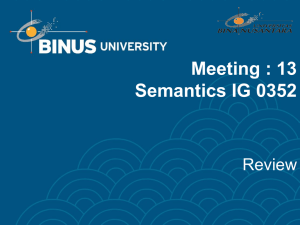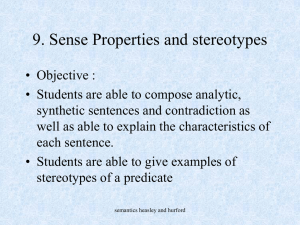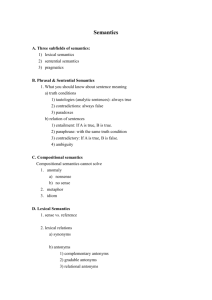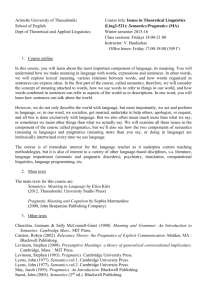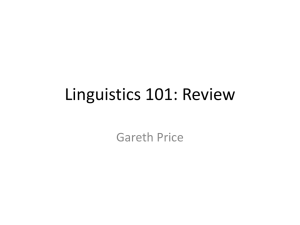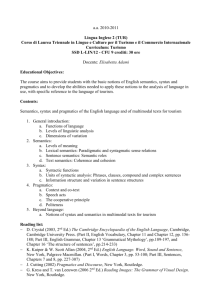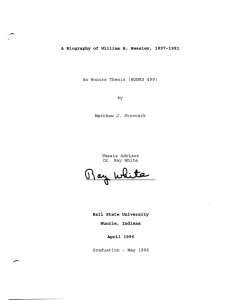ELL218F: LINGUISTICS IIA
advertisement
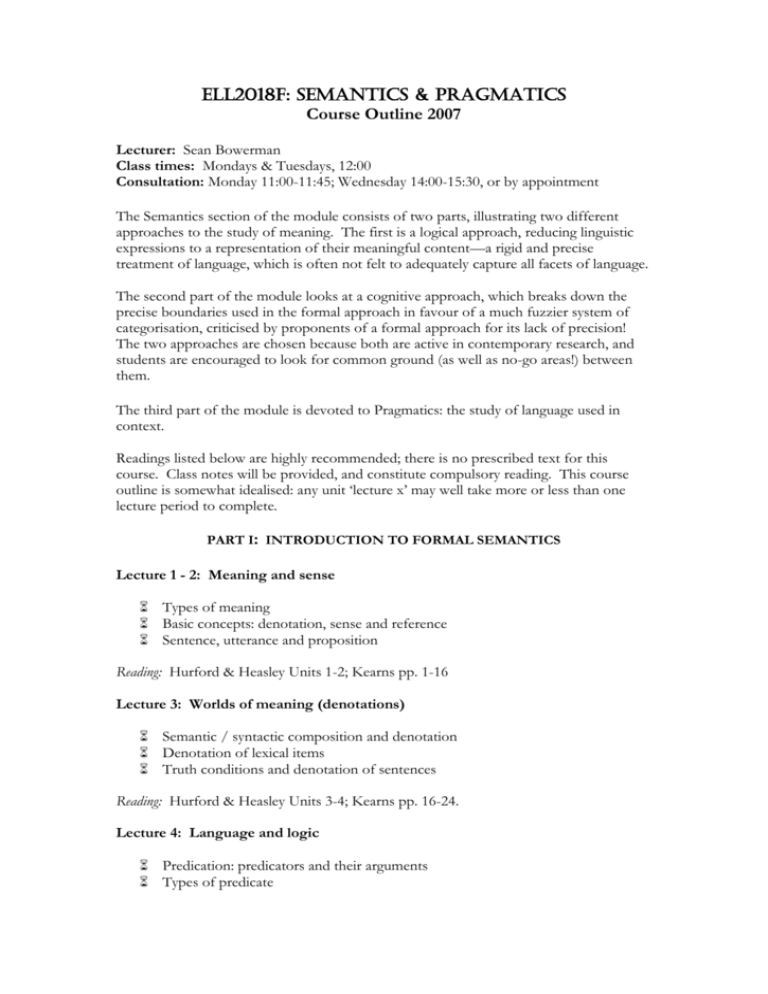
ELL2018F: semantics & Pragmatics Course Outline 2007 Lecturer: Sean Bowerman Class times: Mondays & Tuesdays, 12:00 Consultation: Monday 11:00-11:45; Wednesday 14:00-15:30, or by appointment The Semantics section of the module consists of two parts, illustrating two different approaches to the study of meaning. The first is a logical approach, reducing linguistic expressions to a representation of their meaningful content—a rigid and precise treatment of language, which is often not felt to adequately capture all facets of language. The second part of the module looks at a cognitive approach, which breaks down the precise boundaries used in the formal approach in favour of a much fuzzier system of categorisation, criticised by proponents of a formal approach for its lack of precision! The two approaches are chosen because both are active in contemporary research, and students are encouraged to look for common ground (as well as no-go areas!) between them. The third part of the module is devoted to Pragmatics: the study of language used in context. Readings listed below are highly recommended; there is no prescribed text for this course. Class notes will be provided, and constitute compulsory reading. This course outline is somewhat idealised: any unit ‘lecture x’ may well take more or less than one lecture period to complete. PART I: INTRODUCTION TO FORMAL SEMANTICS Lecture 1 - 2: Meaning and sense Types of meaning Basic concepts: denotation, sense and reference Sentence, utterance and proposition Reading: Hurford & Heasley Units 1-2; Kearns pp. 1-16 Lecture 3: Worlds of meaning (denotations) Semantic / syntactic composition and denotation Denotation of lexical items Truth conditions and denotation of sentences Reading: Hurford & Heasley Units 3-4; Kearns pp. 16-24. Lecture 4: Language and logic Predication: predicators and their arguments Types of predicate Complex predication Reading: Hurford & Heasley Units 5 and 12-13; Kearns pp. 35-41 Lecture 5: Logical operations The basic AUX operators: Tense, Aspect and Modality Operators and truth conditions Negative and Interrogative operators Operators and scope Reading: Hurford & Heasley Units 14-15; Kearns pp. 25-34. Lecture 6: Logical quantifiers Existential quantifiers Universal quantifiers Negation and quantification Quantifier scope Reading: Kearns pp. 41-51. PART II: INTRODUCTION TO COGNITIVE SEMANTICS Lecture 7: The representation of meaning as categorisation Meaning vs. category Classical and prototype approaches to meaning Boundaries Reading: Taylor Ch. 2-3.2; class notes. Lecture 8: Levels of categorisation Levels of categorisation How do we determine levels of categorisation? Folk vs. expert categorisation Revisiting boundaries: hedging Reading: Taylor Ch. 3.3-4. Lecture 9: Sense revisited Metaphor in a formal approach Elastic boundaries: category extension Metonymy and metaphor Taylor Ch. 7; class notes. Lecture 10: Semantics and grammar (i) The role of grammatical categories in conveying meaning: o Grammatical morphology o Grammatical operations Grammatical objects and formal representations Lecture 11: Semantics and grammar (ii) The elasticity of grammatical categories Polysemous grammatical categories Taylor Ch. 8 PART III: PRAGMATICS Lecture 12: Grice The Principle of Coversational Cooperation The maxims of cooperation Reading: Levinson Ch. 3.1 Lecture 13: Speech acts (i) Utterance vs. proposition The Descriptive Fallacy Types of utterance / speech act Illocution and perlocution Reading: Hurford & Heasley Units 21-22. Lecture 14: Speech acts (ii) Illocutionary force Directness Felicity Reading: Hurford & Heasley Units 23-24. Lecture 15: Implicature and presupposition A more formal approach to pragmatics Conversational implicature Information: presupposition Reading: Hurford & Heasley Unit 26; Levinson Chs 4.0-4.2 Lecture 16: General review Please bring any questions you may have about the Semantics and Pragmatics module to this lecture. READING LIST Note that there is no prescribed text for this course; but there are prescribed readings. These are available from Short Loan. Hurford, James & Heasley, Brendan (1993). Semantics: a Coursebook. Cambridge, Cambridge University Press. Kearns, Kate (2000). Semantics. Houndsmills, Macmillan. Levinson, Stephen (1985). Pragmatics. Cambridge, Cambridge University Press. Taylor, John (1995). Linguistic Categorization: prototypes in linguistic theory. Oxford, Oxford University Press. Outcomes ******* This module gives students a thorough introduction to three important perspectives on the study of meaning in language. It provides a basis for more advanced study in semantics, as well as for specialisation in the field.
